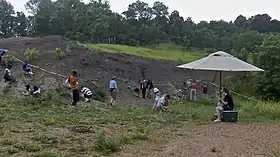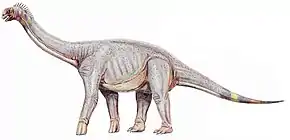Formation d'Arundel
La formation d'Arundel est une formation géologique sédimentaire riche en argiles, que l'on trouve dans le Maryland[1], aux États-Unis. Elle date de l'Aptien (Crétacé inférieur). Cette couche géologique a une importance économique du fait de la présence de fer en son sein, mais elle est surtout connue pour ses dinosaures fossilisés. Souvent considérée comme une formation, il pourrait s'agir en fait d'un simple faciès[2].
Pour les articles homonymes, voir Arundel.
| Formation d'Arundel | |||
 recherche de fossiles dans le Dinosaur Park | |||
| Localisation | |||
|---|---|---|---|
| Coordonnées | 39° 03′ 00″ nord, 76° 38′ 00″ ouest | ||
| Pays | |||
| Subdivision | |||
| Informations géologiques | |||
| Période | Aptien | ||
| Âge | 125.0–113.0 Ma | ||
| Puissance moyenne | 40 m | ||
| Géolocalisation sur la carte : Maryland
Géolocalisation sur la carte : États-Unis
| |||
Paléofaune vertébrée
Dinosaures
Les dinosaures comprennent peut-être le grand théropode Acrocanthosaurus[3],[4]. Les théropodes mal connus Allosaurus (ou « Dryptosaurus ») medius, Creosaurus (ou « Dryptosaurus ») potens (également appelé « Capitalsaurus »), et Coelurus gracilis, l'ornithomimosaurien Coelosaurus affinis, les sauropodes Astrodon et Pleurocoelus, le nodosauridé Priconodon[5], un ceratopsia, et peut-être l'ornithopode Tenontosaurus[2]. Des vertébrés marins ont été retrouvés dans la formation, comme un requin, au moins trois genres de tortues et un crocodilien[2].
| Dinosaures retrouvé dans la formation d'Arundel | ||||||
|---|---|---|---|---|---|---|
| Genre | Espèce | Lieu | Position stratigraphique | Matériaux | Notes | Images |
|
|
"A." medius[6] |
|
Dent[7] |
Dent de théropode. |
| |
|
A. johnstoni[8] |
"Dent."[10] |
|||||
|
"Capitalsaurus"[11] |
"C." potens |
|
"Vertebré."[7] |
Un néotheropode. | ||
|
|
C. affinis[6] |
Synonyme de "Dryosaurus" grandis | ||||
|
|
"C." gracilis |
"Ongle et dent."[7] |
Dromaéosauridé. | |||
|
|
"C." potens[6] |
reclassé comme "Capitalsaurus" potens | ||||
|
Indeterminé[6] |
|
Un dromaéosauridé | ||||
|
|
"D." grandis |
|
"Éléments de membres."[12] |
Théropode indéterminé parfois considéré comme une espèce d'Ornithomimus et décrit à l'origine décrit comme une espèce d'ornithischien Dryosaurus | ||
|
|
"D." medius |
Synonyme of "Allosaurus" medius | ||||
|
"D." potens[6] |
Synonyme de "Capitalsaurus" potens | |||||
|
|
"O." affinis |
Synonyme de "Druosaurus" grandis | ||||
|
P. altus[6] |
|
"Tibia et péroné."[13] |
||||
|
P. nanus[6] |
|
|||||
|
Indeterminé[9] |
|
|||||
|
P. crassus[6] |
|
"Dent, tibia."[14] |
||||
|
Indeterminé[15] |
|
|||||
Ptérosaures
| Ptérosaures de la formation d'Arundel | ||||||
|---|---|---|---|---|---|---|
| Genre | Espèce | Lieu | Position stratigraphique | Abondance | Notes | Images |
|
Pteraichnus[16] |
||||||
Références
- (en) « Geologic Map Legends », Coastal Plain Rocks and Sediments, Maryland Geological Survey (consulté le )
- (en) Peter M. Kranz, Lower and Middle Cretaceous Terrestrial Ecosystems, Lucas, Spencer G.; Kirkland, James I.; & Estep, J.W. (eds.), coll. « New Mexico Museum of Natural History and Science Bulletin 14 », , 235–238 p., « Mostly dinosaurs: a review of the vertebrates of the Potomac Group (Aptian Arundel Formation), USA »
- (en) Jerald D. Harris, Lower and Middle Cretaceous Terrestrial Ecosystems, Lucas, Spencer G.; Kirkland, James I.; & Estep, J.W. (eds.), coll. « New Mexico Museum of Natural History and Science Bulletin 14 », , 225–228 p., « Large, Early Cretaceous theropods in North America »
- (en) Thomas R. Lipka, Lower and Middle Cretaceous Terrestrial Ecosystems, Lucas, Spencer G.; Kirkland, James I.; & Estep, J.W. (eds.), coll. « New Mexico Museum of Natural History and Science Bulletin 14 », , 229–234 p., « The affinities of the enigmatic theropods of the Arundel Clay facies (Aptian), Potomac Formation, Atlantic Coastal Plain of Maryland »
- (en) David B. Weishampel, The Dinosauria, Berkeley, University of California Press, , 2nd éd., 517–606 p. (ISBN 0-520-24209-2), « Dinosaur distribution »
- "3.25 Maryland, United States; 1. Arundel Clay," in Weishampel, et al. (2004). Page 556.
- "Table 4.1," in Weishampel, et al. (2004). Page 78.
- "3.25 Maryland, United States; 1. Arundel Clay" and "3.34 Washington D. C., United States; 1. Arundel Clay," in Weishampel, et al. (2004). Page 556.
- "3.34 Washington D. C., United States; 1. Arundel Clay," in Weishampel, et al. (2004). Page 556.
- "Table 13.1," in Weishampel, et al. (2004). Page 270.
- Kranz, D. 1998. Mostly Dinosaurs: A Review of the Vertebrates of the Potomac Group (Aptian Arundel Formation), USA, in Lucas, Kirkland and Estep, eds., 1998: 235-238.
- "Table 6.1," in Weishampel, et al. (2004). Page 139.
- "Table 13.1," in Weishampel, et al. (2004). Page 266.
- "Table 17.1," in Weishampel, et al. (2004). Page 368.
- Listed as "?Tenontosaurus sp." in "3.25 Maryland, United States; 1. Arundel Clay," in Weishampel, et al. (2004). Page 556.
- Lockley, M.; Harris, J.D.; and Mitchell, L. 2008. "A global overview of pterosaur ichnology: tracksite distribution in space and time." Zitteliana. B28. p. 187-198. (ISSN 1612-4138).
- Portail de la géologie
- Portail des dinosaures
- Portail du Maryland

_relief_location_map.png.webp)


